[ad_1]
Tetras are an ever-popular group of small tropical fish that can be found in nearly every home aquarium setup.
These small schooling fish are great for beginner and experienced hobbyists alike. With 150 species to choose from, there are many ways you could bring your freshwater aquarium to life.
Keep reading to find out everything you need to know about tetras, the many different species available, and how to keep this hardy fish in your own aquarium setup!
Introduction to Tropical Tetras
The tetra name is the all-inclusive standard for identifying many varieties of tropical freshwater characiform fish in the biological family, Characidae.
These tropical fish originate from warm water ecosystems throughout Africa, Central America, and South America, and many species are collected specifically from the Amazon region.
Tetras are typically distinguished by their small adipose fin set between the caudal and dorsal fins. Most tetras are brightly colored, making them an immediate hit with fishkeeping enthusiasts around the world.
In addition to their bright colors, these fish stay relatively small and are easy to keep. They fit into most community tank setups, but can easily fill a fish tank all on their own.
Identification
Although each tetra species is different in coloration, their conformation is essentially the same. Tetras typically have a deep, compressed body, and are easily identifiable by their finnage.
The tail is forked with upper and lower lobes of equal size. The dorsal fin is tall with a short connection to the body. Tetras also have a long anal fin extending from just behind the dorsal fin, finishing on the ventral caudal peduncle.
There is also a smaller fin located between the caudal and dorsal fins. That fin forms the fish’s fourth unpaired fin and gives the fish its name tetra, from the Greek word meaning four.
Most tetras are small fish, measuring up to an inch (2.5 cm) or so in length, depending on the species.
For comparison, one of the largest tetras available is the Congo tetra (Phenacogrammus interruptus) which grows to be 3 inches (7.6 cm).
Like most small tropical fish species, tetras have a relatively short lifespan of up to around 4 years. However, it’s not unheard of for them to live much longer in ideal water quality and tank conditions.
What Is The Most Peaceful Tetra Species?
The majority of tetra species are peaceful. As we’ll see, there are a few that like to nip at smaller fish, but for the most part tetra aggression is nothing to worry about.
That being said, there are some more peaceful species available if you’re really worried.
What Is the Most Aggressive Tetra Species?
Though most species of tetra are peaceful, there are some varieties that are known for fin-nipping. Some of these include the Diamond, Bleeding Heart, Serpae, and Congo tetra.
In general, the larger species on this list will be more likely to fin nip than the smaller ones, though this isn’t true for all of them and research should be conducted for each individual species.
Tetra Tank Requirements
There are a few simple ways to make your tetra feel especially at home. These fish easily fit into community setups but can be kept on their own as well.
Most schooling species of tetra require at least 10 gallons of water (37.9 L) to comfortably form a group. They can be kept with sand or gravel substrate and fake or live plants as long as there is a filter and heater since they are tropical species.
Ideal water parameters for most tetras is:
- Temperature: 72-82° F (22.2-27.8° C)
- pH: 5.5-7.5
- Alkalinity: 2-10 dkH
As we’ll discuss, most tetras come from tannin-rich waterways that cause the water to be murky and acidic in return.
Tetra Biotopes
One popular tetra setup is a biotope. A biotope represents the natural habitat from where the fish species originates.
For example, South American species of tetras live in soft-water rivers with stained water, a soft, sandy substrate, and bogwood.
These habitats are typically dimly lit, as they are surrounded by dense rainforests. Some environments are heavily vegetated, whereas others have no plants at all, being filled with fallen leaves from overhanging trees.
If you want to create an authentic Amazonian community tank, keep several groups of tetras with pencilfish, hatchetfish, Corydoras catfish, and Apistogramma dwarf cichlids.
The effort you put into creating the perfect biotope for your fish will be rewarded with brighter colors and more authentic fish behavior. Your tetras may even begin to spawn naturally in your tank!
Tetra Tank Mates
Outside of a biotope, there are many tank mate options for whichever tetra species you end up choosing.
Some of the most popular community tank mates for tropical tetras include:
- Gourami
- Angelfish
- Corydoras
- Rasboras
- Danios
- Livebearers
- Other tetras
In fact, tetras can sometimes even be kept with more aggressive species, like piranha and arowana.
This is because tetras are usually too fast and too small to interest larger fish. Their schooling behavior can also help deter larger predators, making them pretty easy to replace in worst-case scenarios as well.
How Many Tetras Can Be Kept Per Gallon?
Tetras need to be kept in schools of fish. When kept alone, they quickly succumb to stress and other illnesses.
Ideally, you will want to have at least six tetras per school. From there, the limit is only based on how large your tank is.
That being said, it’s very easy to overstock tetras because they need to be kept in larger schools. A good rule of thumb is about six tetras for every 10 gallons of water.
Of course, this will depend on the footprint of the tank as well as the other fish in the aquarium.
Tetra Diet
One of the reasons tetras are so easy to care for is because they’ll eat anything. These tropical aquarium fish are omnivores and will happily eat plant-based and meat-based fish foods.
A varied diet will result in the best vibrancy and intensity of color in tetras. Keep in mind that tetras have tiny mouths, so larger fish foods will need to be cut up for them.
Tropical tetras will enjoy an assortment of live, frozen, and freeze-dried bloodworms, mysis shrimp, and brine shrimp. A high-quality freshwater fish flake or pellet should be at the center of a tetra’s diet.
You can occasionally feed tetras algae wafers, pellets, and blanched vegetables as well.
The Best Tropical Tetras For Your Freshwater Aquarium
Before jumping into our list of the best freshwater tetras available, remember to fully research any species you plan on purchasing as requirements may differ from one to the next.
We’ll take a look at several of the most commonly seen and popular tetra species that can be found in fish stores and pet shops, and focus on some of the more unusual variations that you may want to consider adding to your community tank!
Neon Tetra
- Scientific name: Paracheirodon innesi
- Tank size: 10 gallons (37.9 L)
- Mature size: 1.25 inches (3.2 cm)
Neon tetras are perhaps the most popular tetra species of all time.
These brilliantly colored, peaceful little fish are easy to keep, small enough for a nano tank, and make a great addition to a community setup.
The Neon tetra is a South American tetra that will enjoy a rainforest biotope environment.
There are several similar species to the Neon tetra, including Green Neon tetras (Paracheirodon simulans) and Black Neon tetras (Hyphessobrycon herbertaxelrodi). Though these fish are similar in name, size, and appearance, they are three different species!
There are also albino and long-finned varieties that make for a more unusual addition to your tank.
Green Neon Tetra
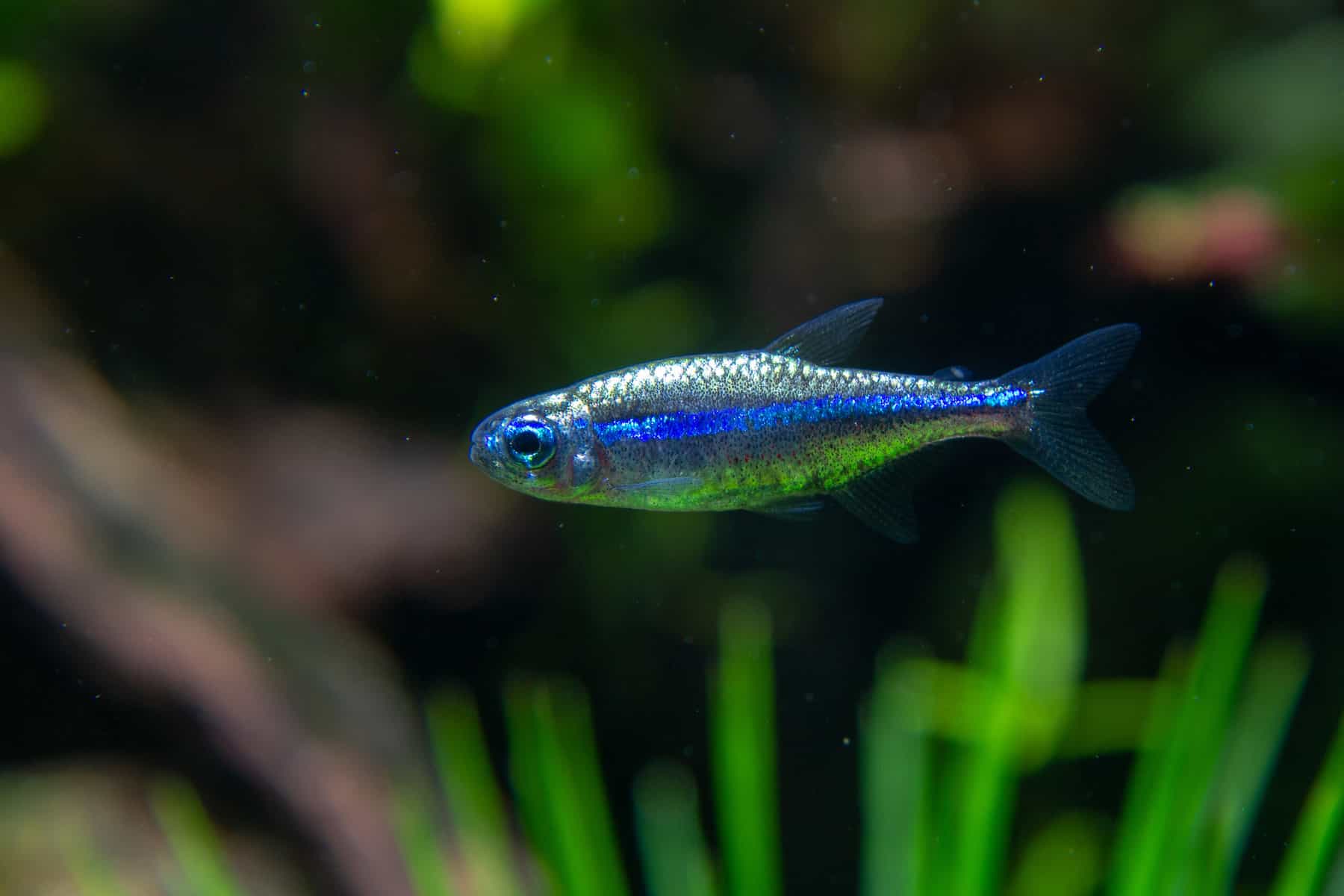
- Scientific name: Paracheirodon simulans
- Tank size: 10 gallons (37.9 L)
- Mature size: 1 inch (2.5 cm)
Green Neon tetras are slightly smaller than Neon tetras and less colorful.
These attractive fish have a very broad blue stripe that runs from the tip of the nose all the way to the base of the tail. Some red may be noticeable on the second half of the body.
These peaceful fish live in pretty secluded areas of the world, in blackwater conditions of the upper Negro and Orinoco River basins. As a result, they are less common to find in the average aquarium store.
Black Neon Tetra
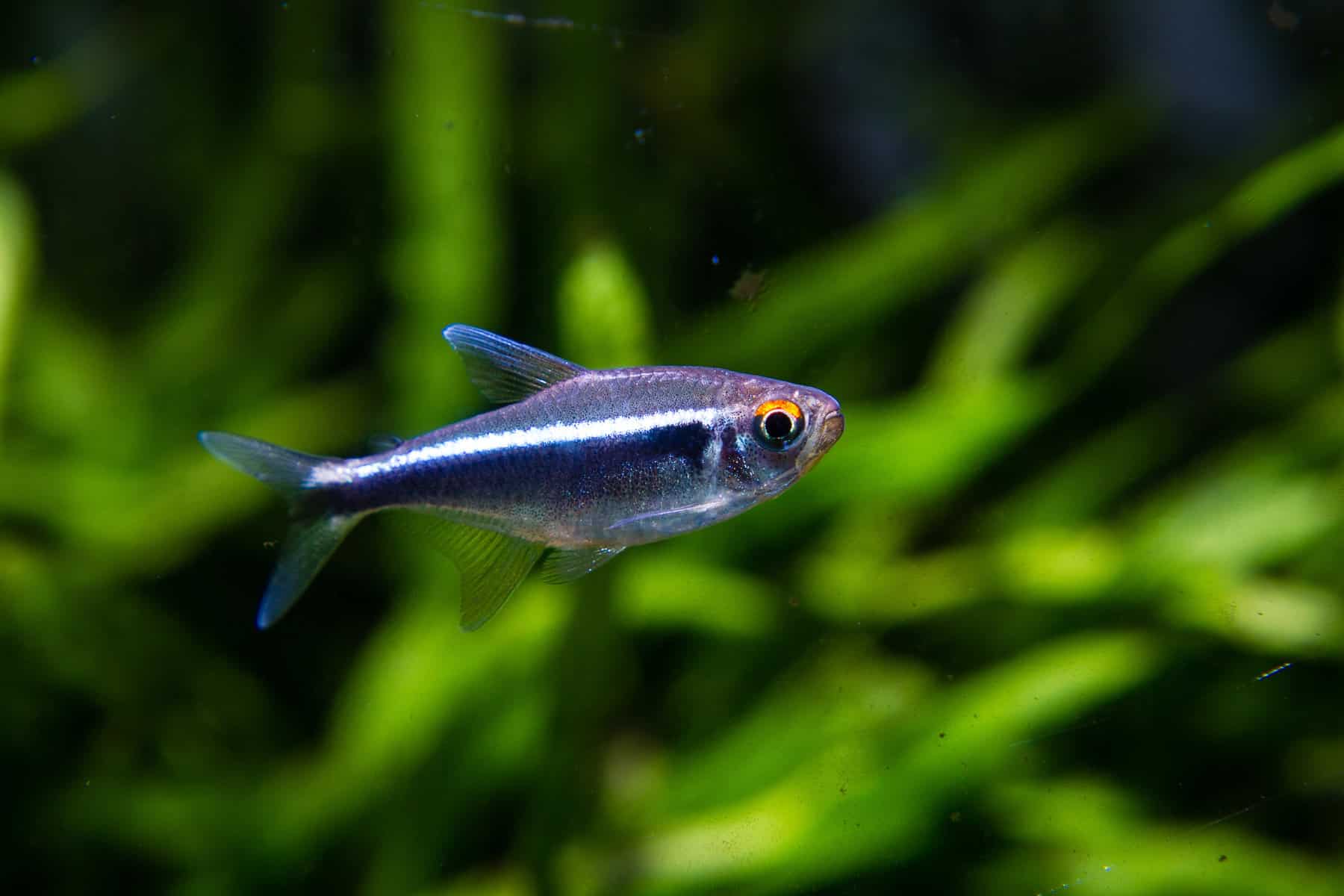
- Scientific name: Hyphessobrycon herbertaxelrodi
- Tank size: 10 gallons (37.9 L)
- Mature size: 1.5 inches (3.8 cm)
The Black Neon tetra might seem like a black and white variation of the Neon tetra, but it’s in a different taxonomical genus altogether.
These small fish originate from South America, mostly throughout portions of Brazil. There, they live in calm, acidic water ecosystems.
In the aquarium, they should be kept in larger schools and given lots of open swimming space at the top of the tank because they are active swimmers.
Cardinal Tetra
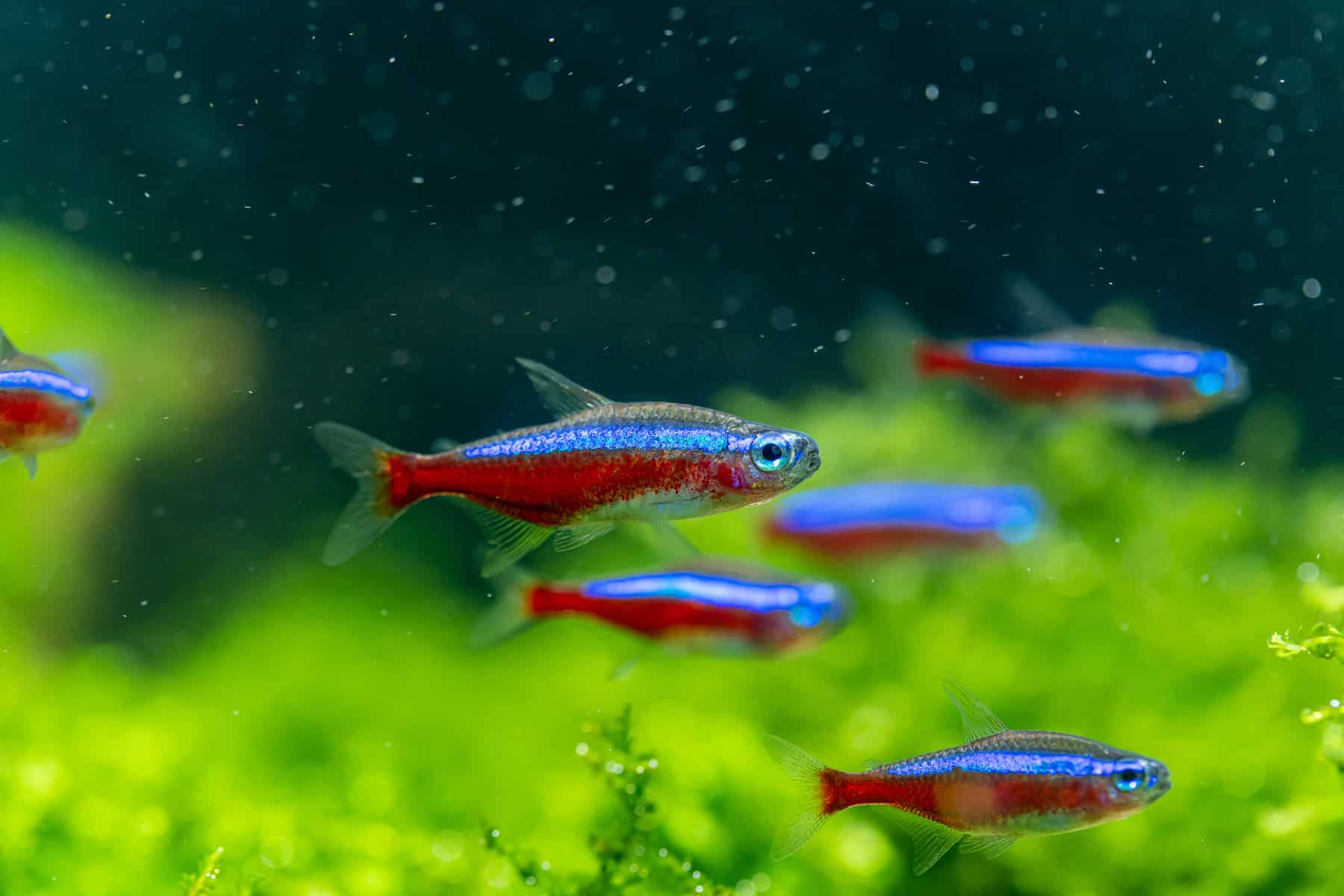
- Scientific name: Paracheirodon axelrodi
- Tank size: 10 gallons (37.9 L)
- Mature size: 2 inches (5.1 cm)
Cardinal tetras are often confused with their neon cousins. However, the Cardinal tetra can be recognized by the red stripe that extends across the full length of the fish’s body, rather than stopping halfway.
In addition, Cardinal tetras are slightly larger than neons and more sensitive to water quality. Other than that, the living conditions and nutritional requirements of the two species are exactly the same.
Cardinal tetras are found in acidic water in the upper Orinoco and Negro River basins of South America.
Ember Tetra
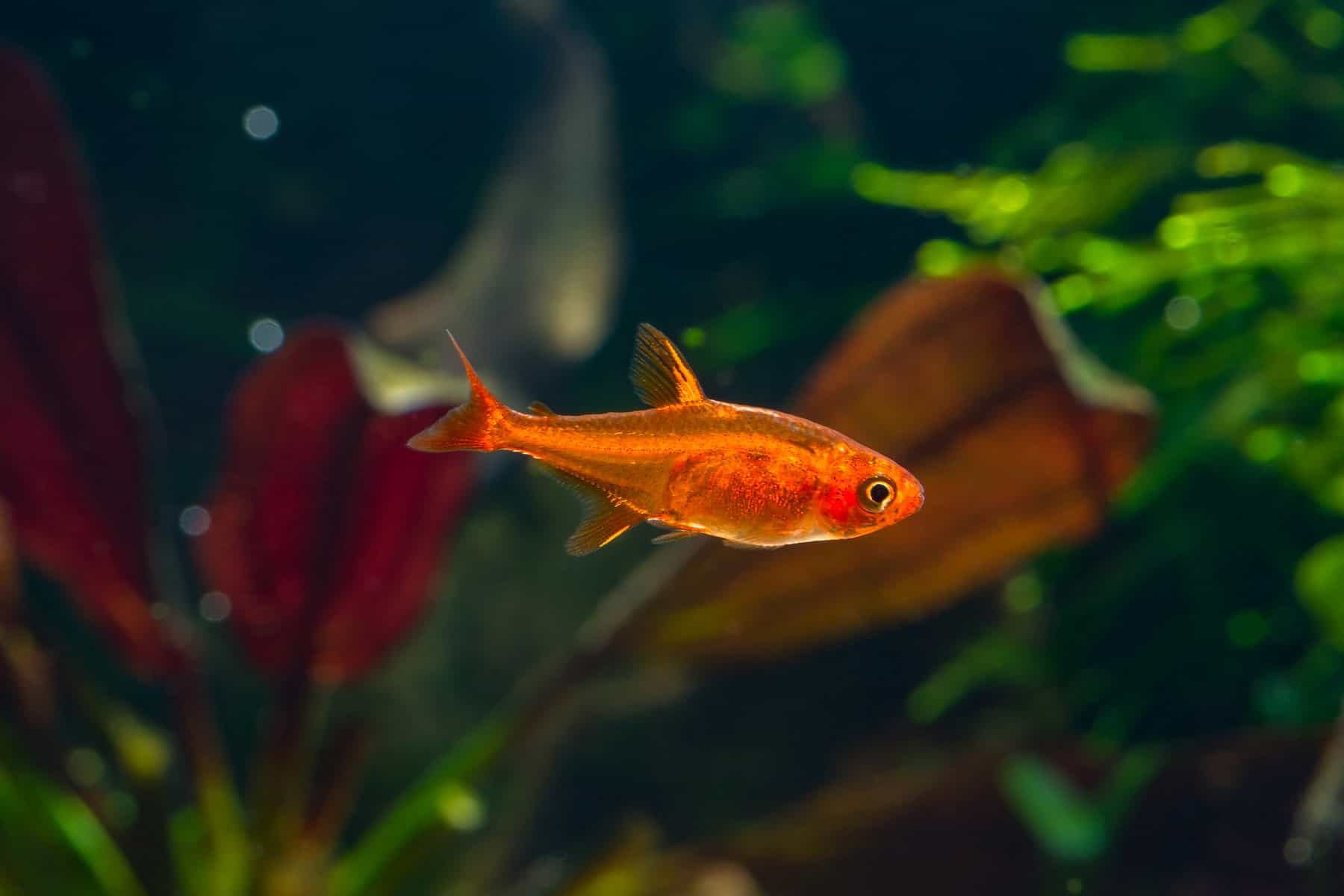
- Scientific name: Hyphessobrycon amandae
- Tank size: 10 gallons (37.9 L)
- Mature size: 1.25 inches (3.2 cm)
Ember tetras originate from the Araguaia River basin in South America. These peaceful tetras are beautiful little fish that add a delightful splash of color to any tank.
This tetra is a relatively recent discovery, being officially recognized in 1987. However, you can find these active fish in most aquarium stores or from online dealers.
Like all tetra species, embers should be kept in schools of at least six or more individuals.
Black Skirt Tetra
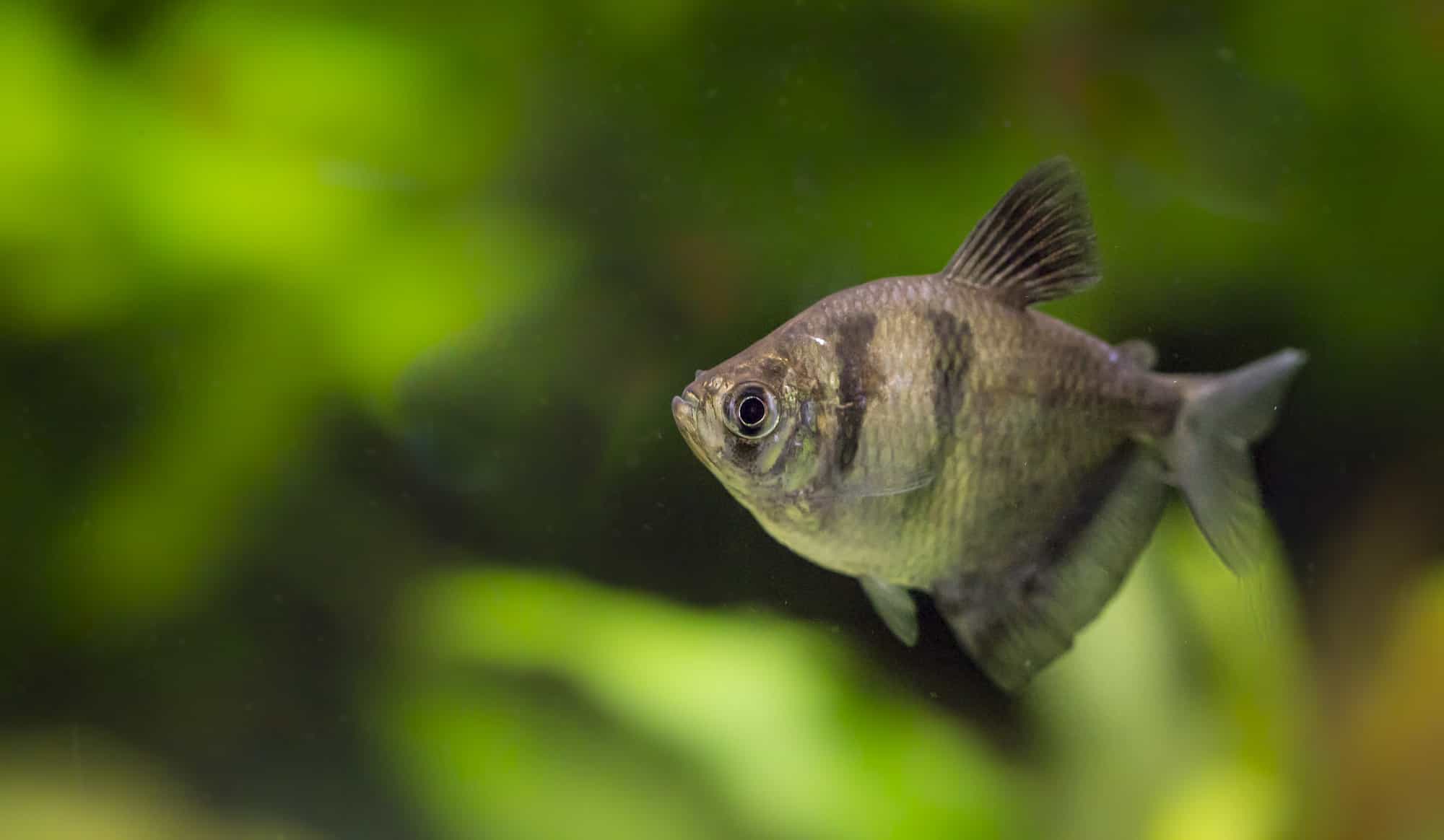
- Scientific name: Gymnocorymbus ternetzi
- Tank size: 20 gallons (75.7 L)
- Mature size: 2.5 inches (6.4 cm)
Though not one of the most colorful species, the Black Skirt tetra has been a popular choice for freshwater community systems for decades; these fish may sometimes be referred to as Black tetra.
These fish originate from the Paraguay and Guaporé River basins in South America. They have deep bodies with silver and black features.
Though labeled as a community fish, Black Skirts are prone to nipping at other types of tetras and tank mates. There isn’t really any way to prevent this, though you can avoid stocking smaller, slow-moving species.
Serpae Tetra
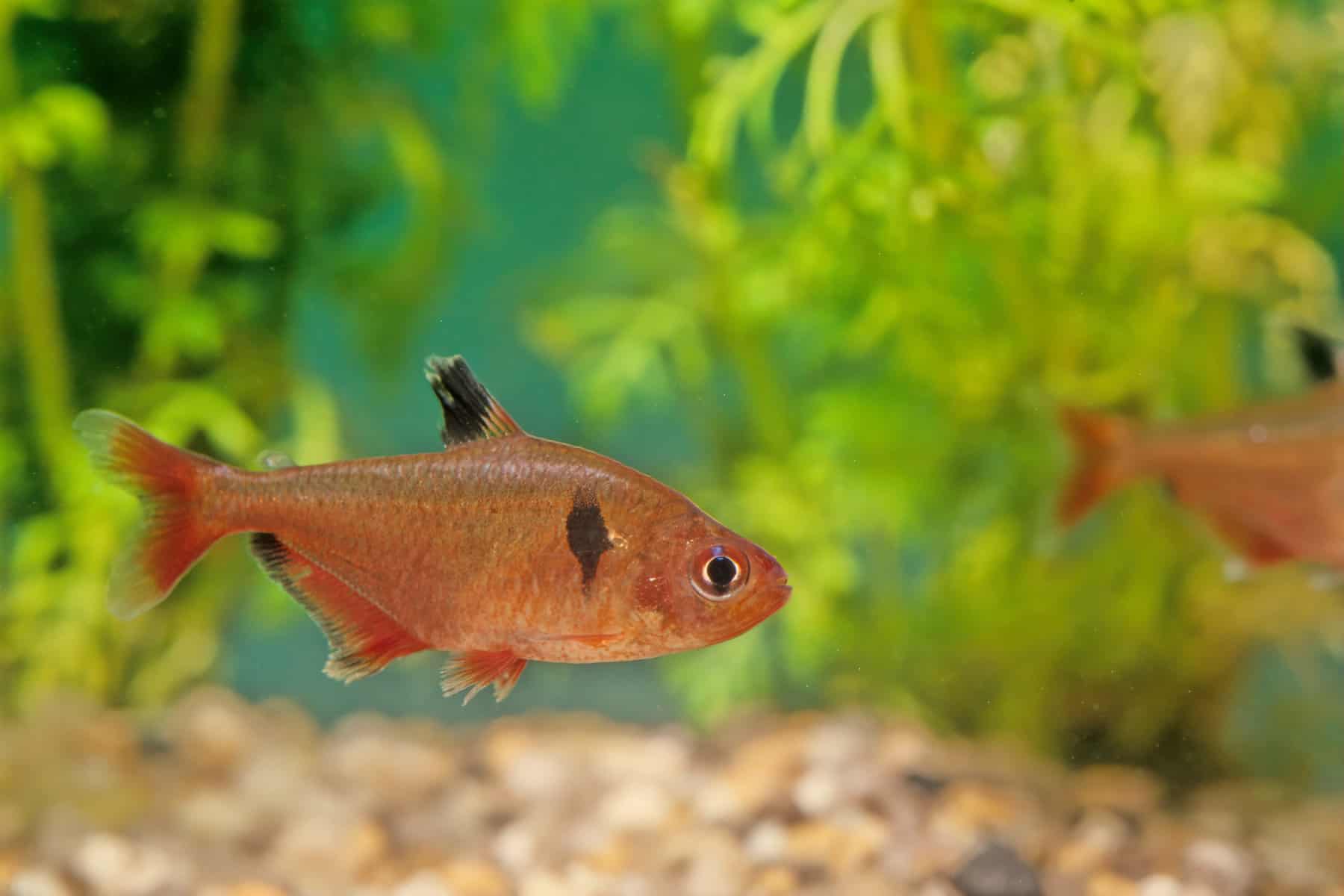
- Scientific name: Hyphessobrycon eques
- Tank size: 20 gallons (75.7 L)
- Mature size: 2 inches (5.1 cm)
Serpae tetras, also known as Jewel tetras, are pretty different from other species. These fish have an orange body with white and black accents, though the overall shape of the body is more rounded than that of the typical tetra.
Serpae tetras are widely found throughout South America in the Amazon, Guaporé, and Paraguay River basins.
In the aquarium, they can be fin nippers so avoid small and slow-moving species.
Lemon Tetra
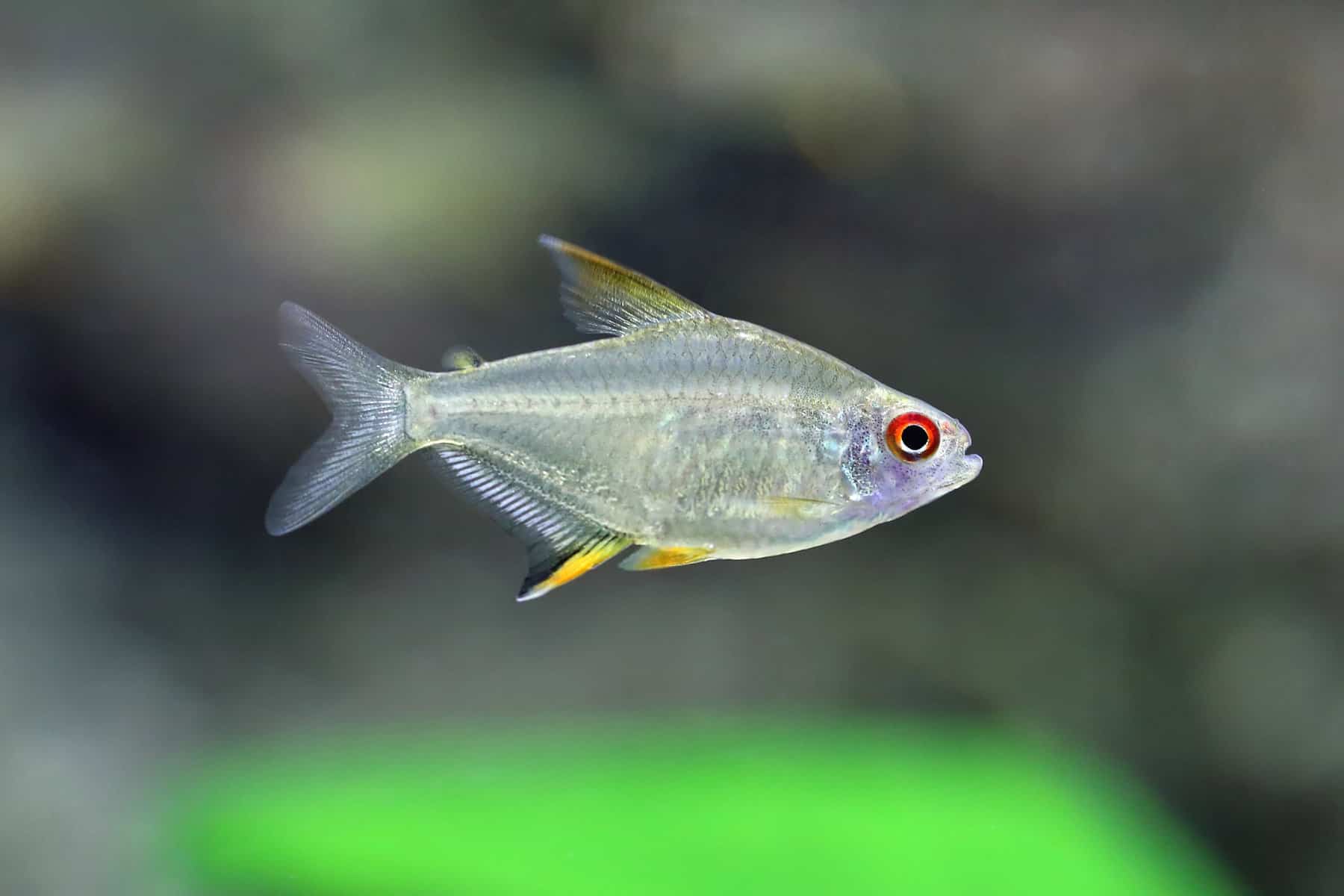
- Scientific name: Hyphessobrycon amandae
- Tank size: 20 gallons (75.7 L)
- Mature size: 2 inches (5.1 cm)
The Lemon tetra is another tetra that comes from the Tapajós River basin in South America. These are very popular fish, but can sometimes be difficult to find in stores.
As a slightly larger species of tetra, the Lemon tetra makes a great addition to a small, well-planted tank. Lemon tetras will get along with other types of tetras and most community fish.
These fish are silvery-yellow but can reach maximum yellow luminosity given the right conditions. As the males of the species mature, their coloration darkens.
Rummy Nose Tetra
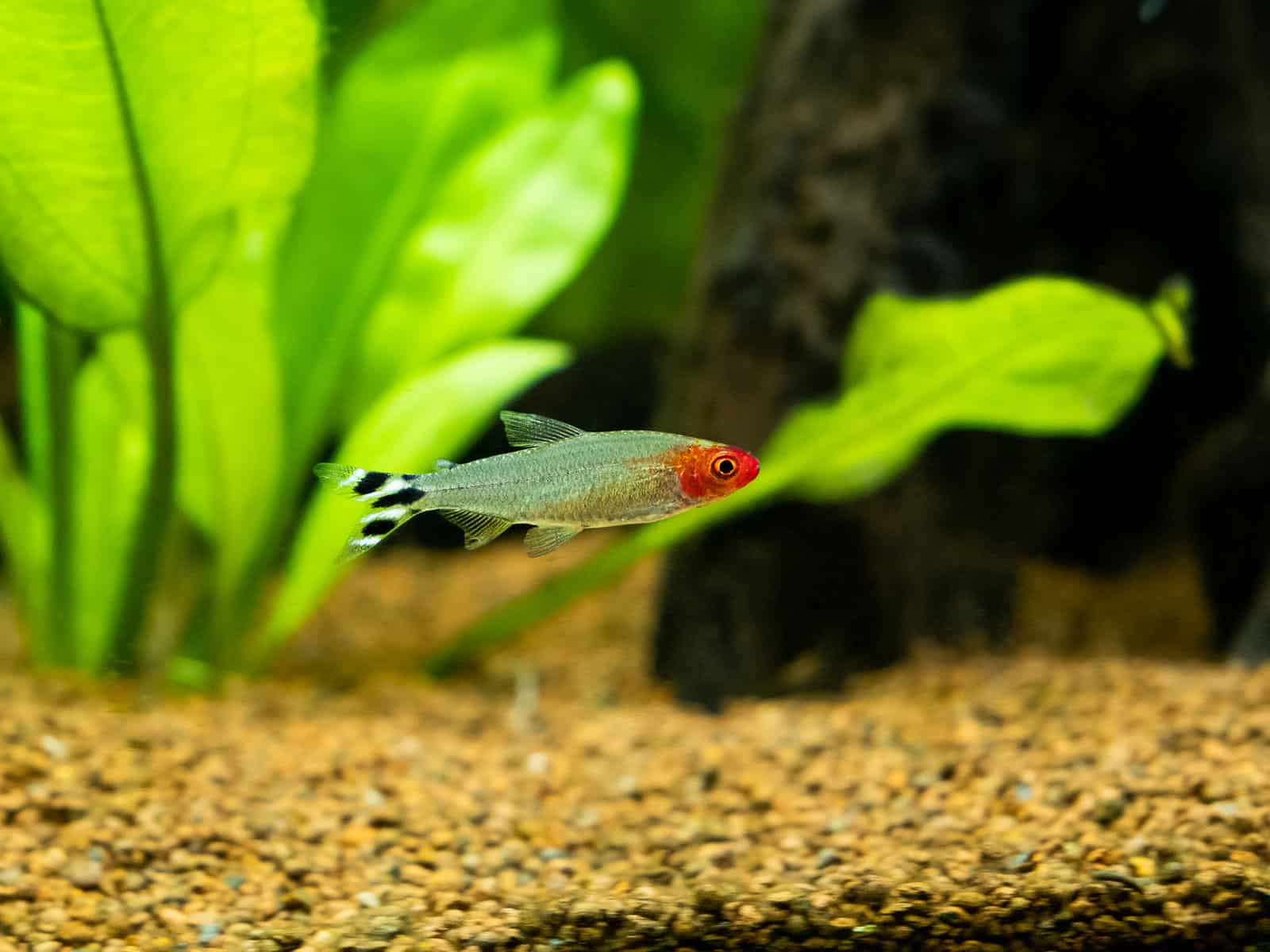
- Scientific name: Hemigrammus bleheri
- Tank size: 10 gallons (37.9 L)
- Mature size: 2 inches (5.1 cm)
The Rummy Nose tetra has gained popularity over the past few years. It is simple in color with a silver body, black and white checkered tail, and bright red head.
They are considered to be a little more difficult than the average species of tetra. Rummy Noses can be shy at first and are more sensitive to imperfect water parameters.
Once established, these fish are very active and can bring life to the middle and top portions of the aquarium.
Bloodfin Tetra
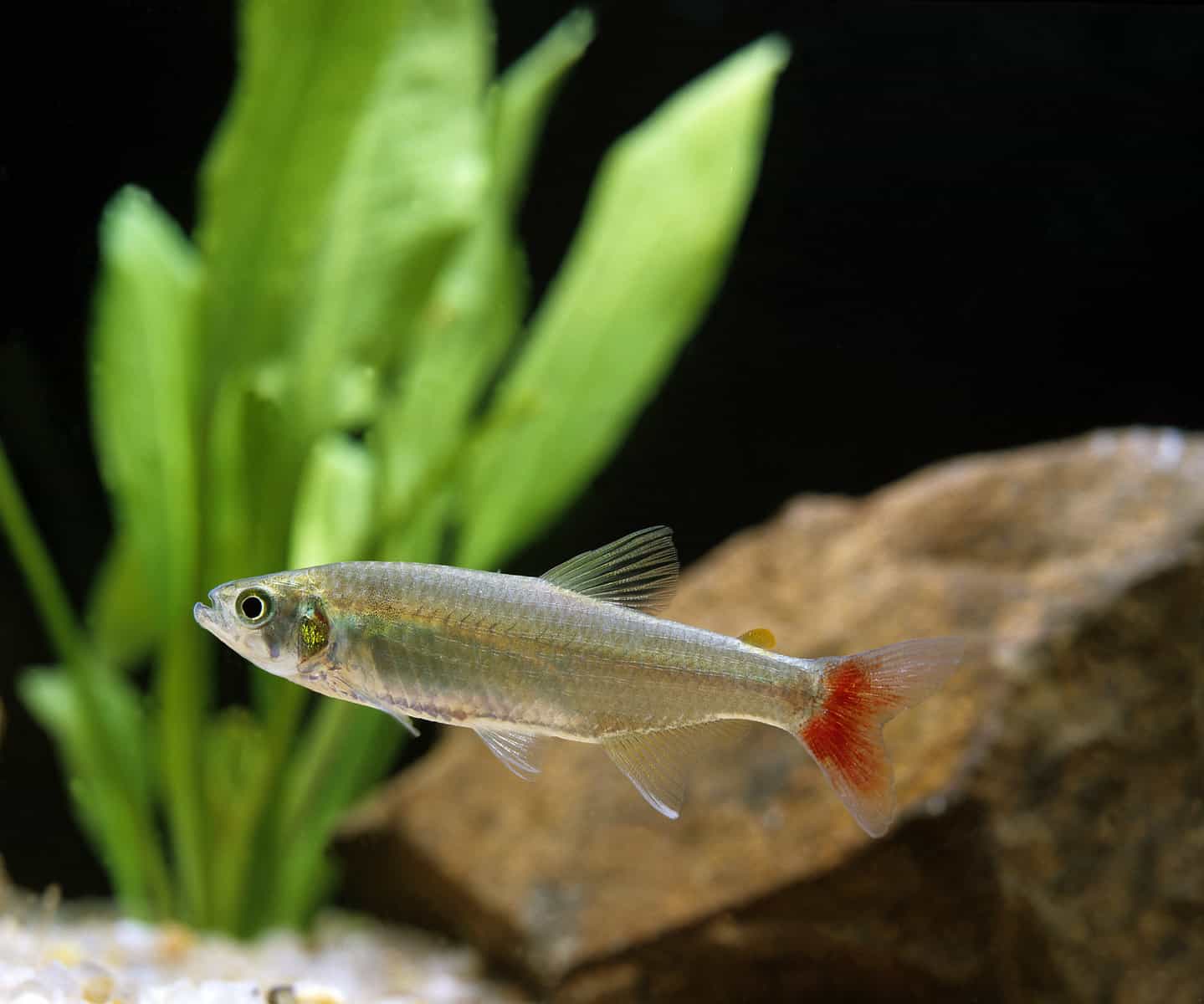
- Scientific name: Aphyocharax anisitsi
- Tank size: 30 gallons (113.6 L)
- Mature size: 2.25 inches (5.7 cm)
The Bloodfin tetra is a great background schooling fish for the community aquarium. These fish are simple in color with a streamlined silver body and signature red tail.
Bloodfin tetras stay relatively small but are incredibly active and need a larger tank than the other popular types of tetra.
These fish originate from the Paraná River basin in South America and can nip at smaller fish. However, they are very hardy and a good choice for beginner hobbyists.
Diamond Tetra
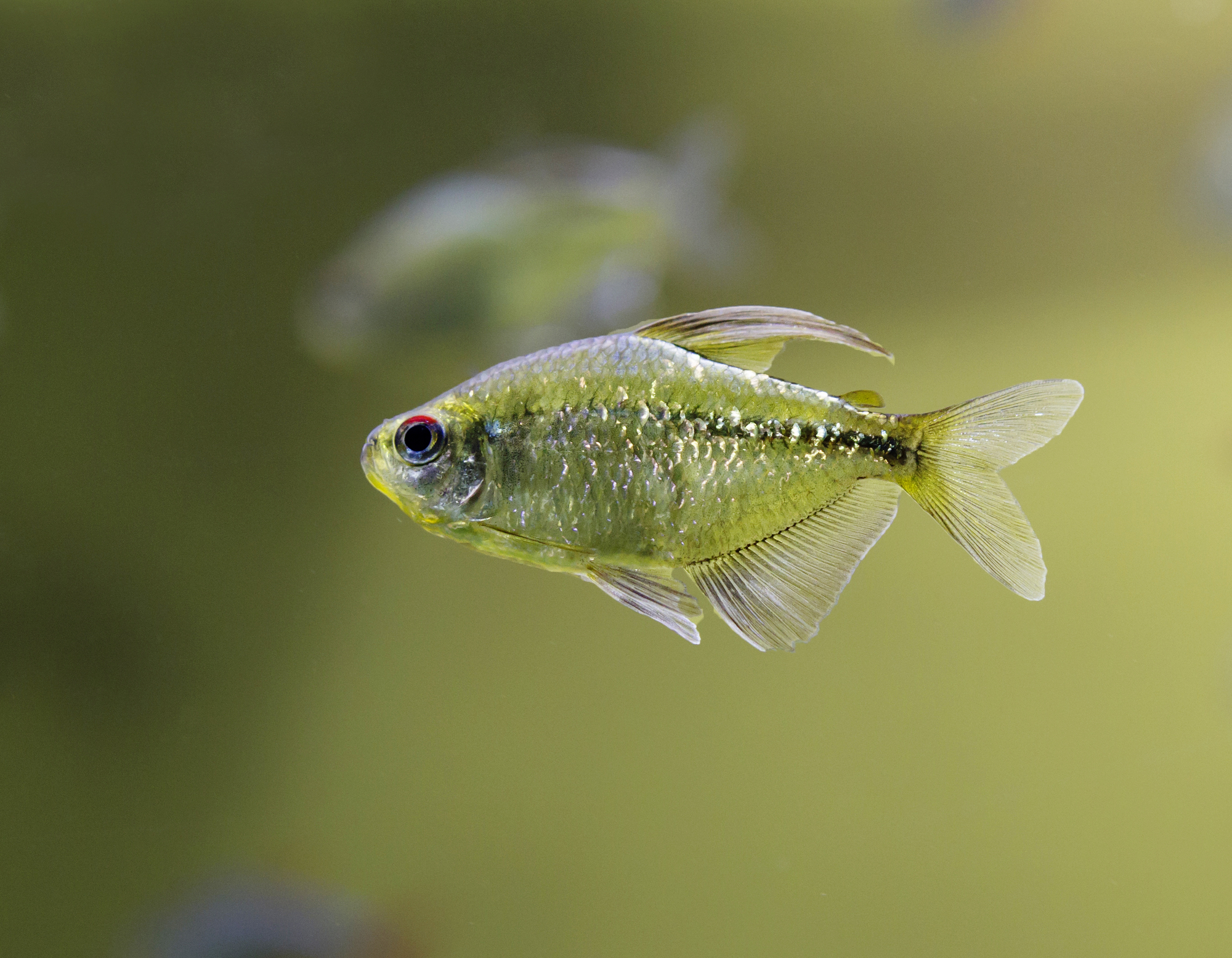
- Scientific name: Moenkhausia pittieri
- Tank size: 20 gallons (75.7 L)
- Mature size: 2.5 inches (6.4 cm)
Another fish simple in appearance, the Diamond tetra comes from the Lake Valencia basin in Venezuela.
These fish do best in large groups in a well-planted tank with lots of hiding places so that this nervous, shy fish feels confident and secure. While the recommended tank size is only 20 gallons, it is recommended to keep them in larger tanks based on school size.
These are one of the larger tetra species with gorgeous flowing fin extensions and dazzling metallic scales.
Congo Tetra
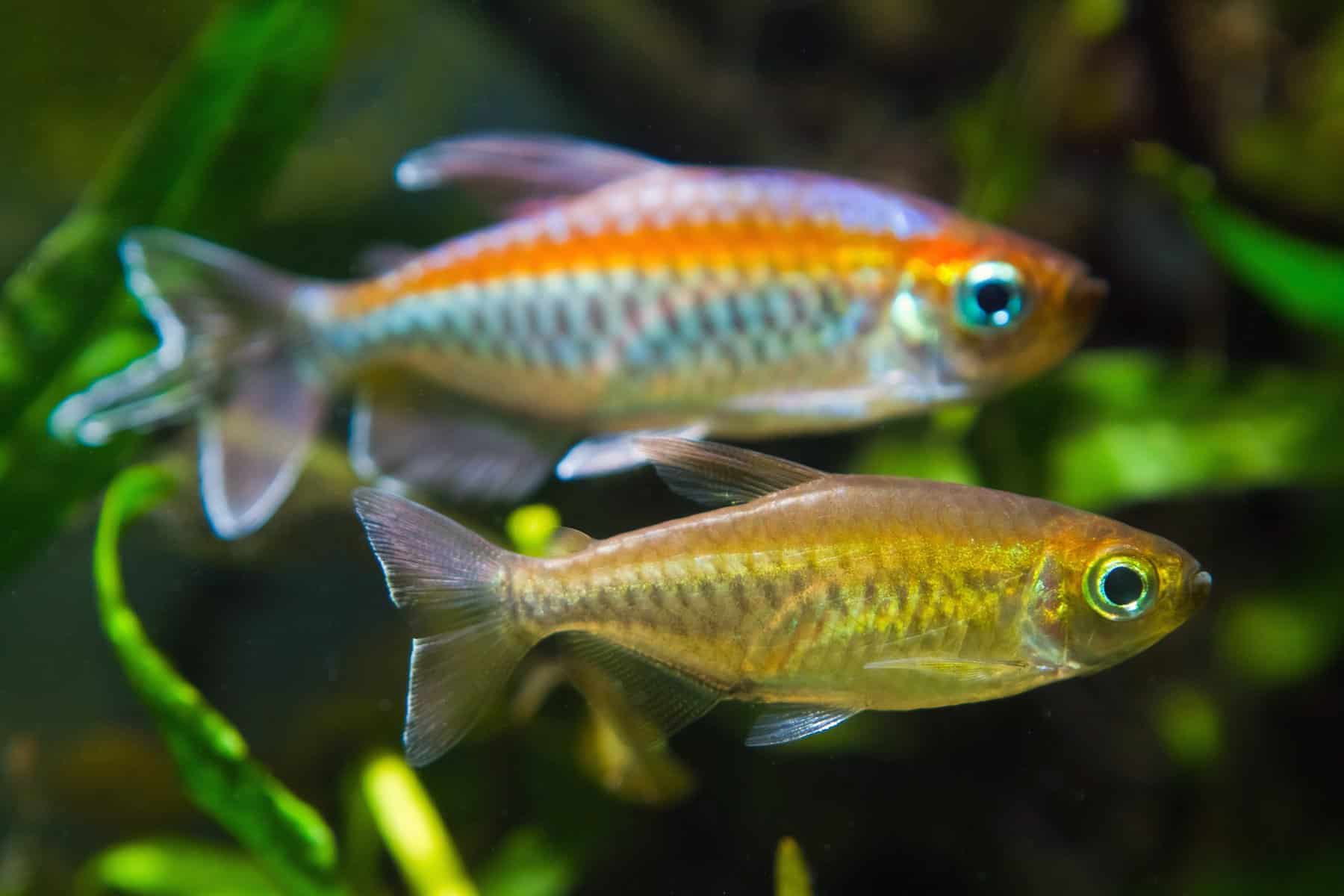
- Scientific name: Phenacogrammus interruptus
- Tank size: 20 gallons (75.7 L)
- Mature size: 3 inches (7.6 cm)
The Congo tetra is one of the largest species on this list, and one of the few tetras that originates from Africa. These fish are iridescent with a flashy silver body and accents of yellow and orange.
Though large, these peaceful fish can become quite reclusive if other larger, more active species are present in the aquarium.
Kitty Tetra
- Scientific name: Hyphessobrycon heliacus
- Tank size: 20 gallons (75.7 L)
- Mature size: 1.25 inches (3.2 cm)
The Kitty tetra comes from South America, specifically from the Teles Pires River in the upper Tapajós basin in Brazil.
This species of tetra is still quite new to the aquarium hobby, but they do make a wonderful addition to your fish tank.
The Kitty tetra has a deep, yellow-orange body with a dark spot near the base of its tail. Males develop an elongated dorsal fin as they mature, increasing their appeal.
Bentosi Tetra
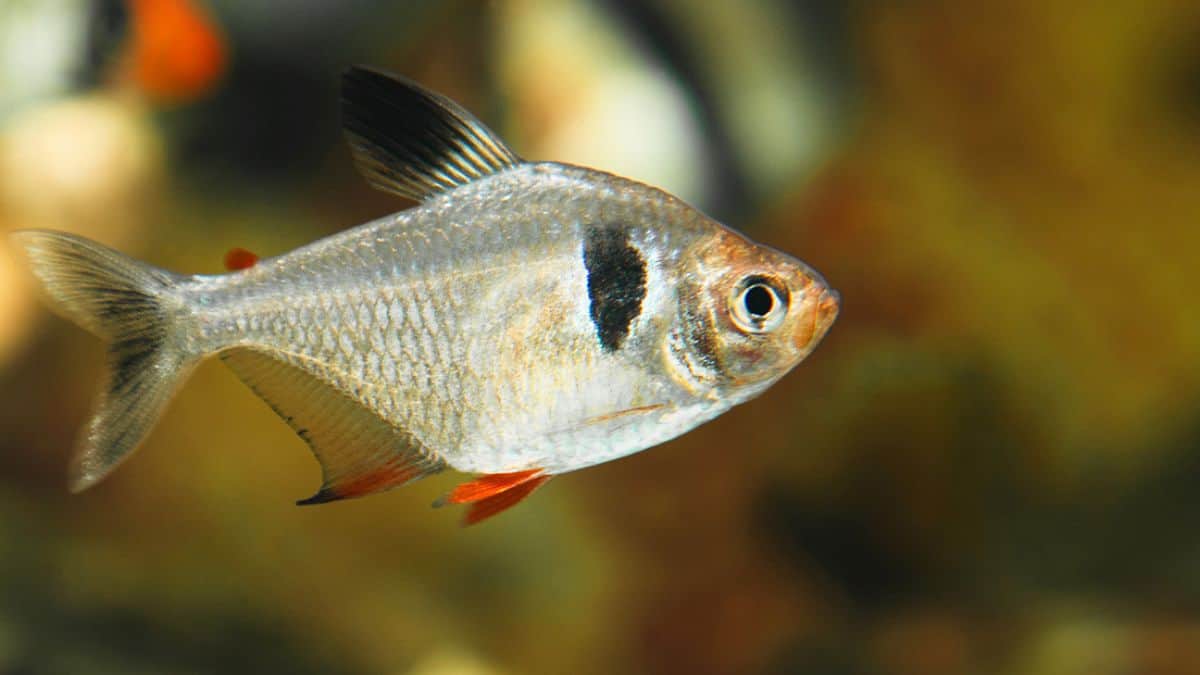
- Scientific name: Hyphessobrycon bentosi
- Tank size: 20 gallons (75.7 L)
- Mature size: 1.75 inches (4.4 cm)
The Bentosi tetra is also sometimes called the Ornate tetra and it’s easy to see why. These elegant, attractive little fish come from the Amazon River basin and are one of the larger tetra species.
These little fish are a smaller alternative to the bleeding heart tetra, with other variants including the Bentosi “white fin.”
Bleeding Heart Tetra
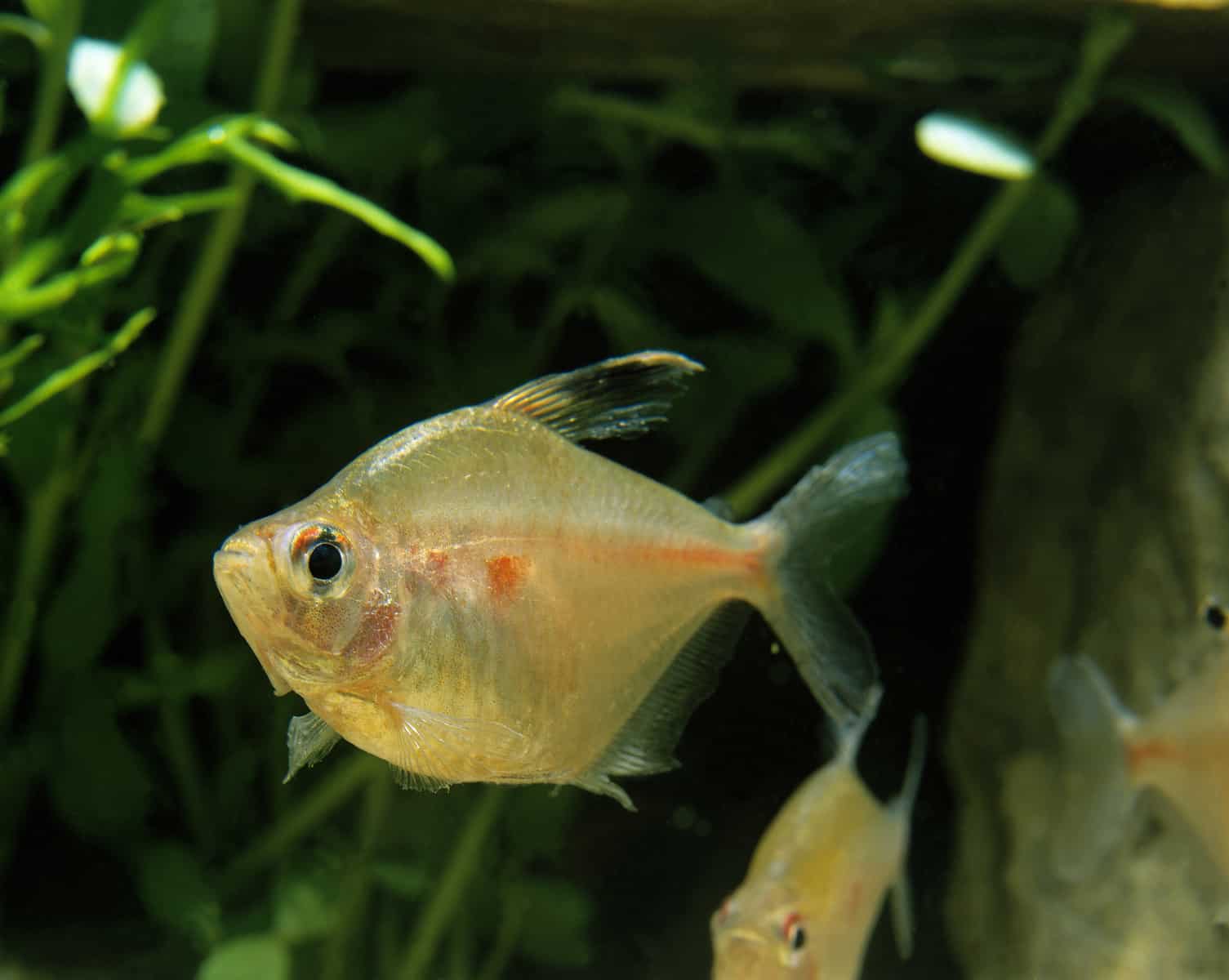
- Scientific name: Hyphessobrycon erythrostigma
- Tank size: 20 gallons (75.7 L)
- Mature size: 2 inches (5.1 cm)
The Bleeding Heart tetra has become increasingly popular over the past few years.
These fish are named after the small red dot right behind their gills. Otherwise, Bleeding Heart tetras are pretty similar in appearance to serpae tetras, though deeper-bodied.
Bleeding Heart tetras originate from the Amazon River and prefer blackwater conditions. They can be kept with most community fish, though might be too active for smaller species.
Emperor Tetra
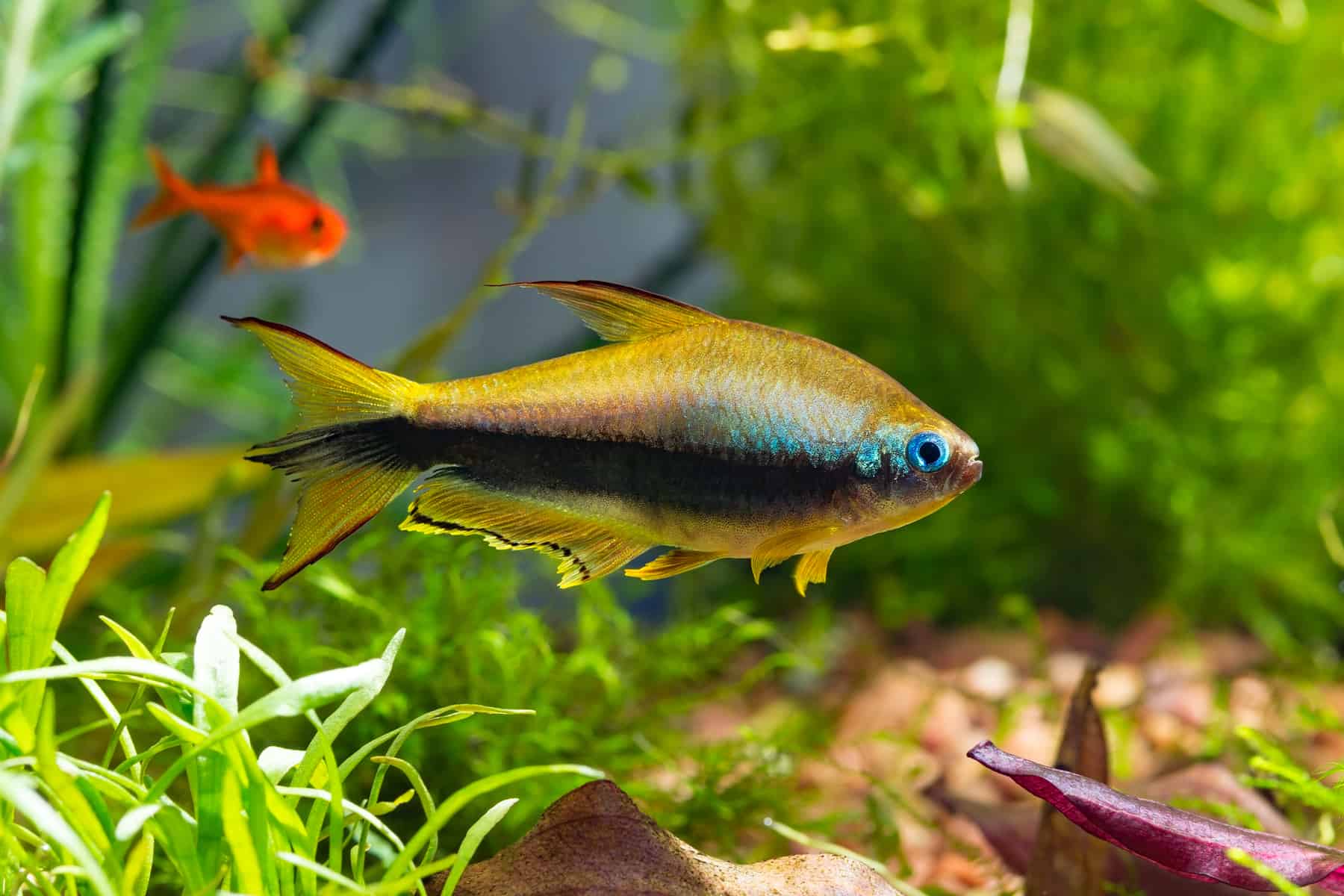
- Scientific name: Nematobrycon palmeri
- Tank size: 10 gallons (37.9 L)
- Mature size: 1.5 inches (3.8 cm)
If you’re looking for a really impressive tetra to add to your community tank, the Emperor tetra has to be on your list.
Hailing from the tropical river basins of San Juan and Atrato in South America, these tetras look truly spectacular when kept in large groups. Like many tetra species, the Emperor tetras become even more beautiful with age.
Though named emperor, these popular aquarium fish stay rather small with their signature blue eyes and lateral black stripe.
Colombian Redfin Tetra
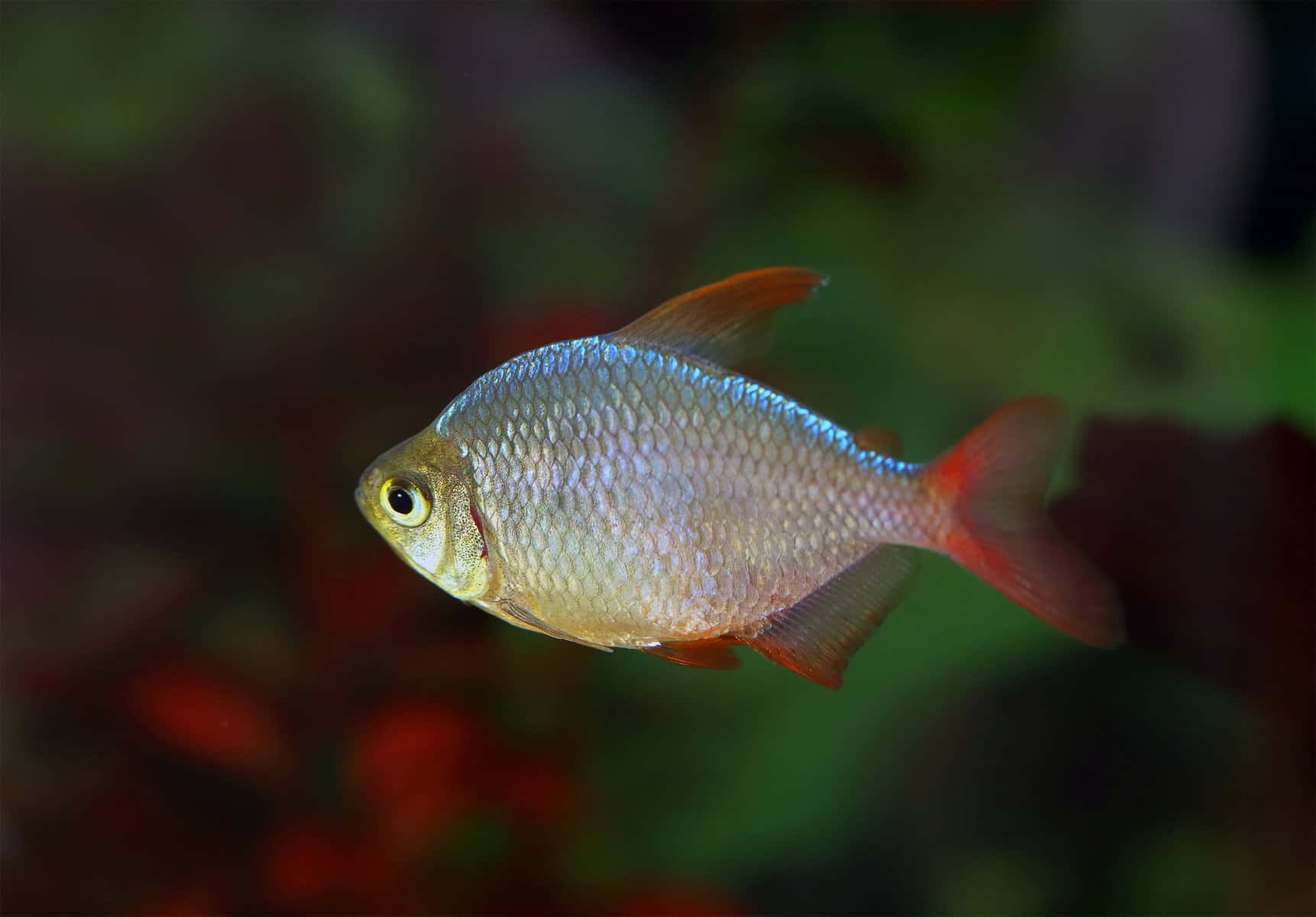
- Scientific name: Hemigrammus rubrostriatus
- Tank size: 30 gallons (113.6 L)
- Mature size: 3 inches (7.6 cm)
If you’re looking for a large tetra for a bigger aquarium setup, the Colombian Redfin tetra could be a good choice. Colombian Redfins grow to be around 3 inches long, making them one of the larger tetra species.
These fish come from the Acanti River basin in Colombia, where they live in small, heavily vegetated streams.
These large, active, and robust fish can be safely housed with medium-sized South American cichlids, and take on a gorgeous blue and red coloration when they are fully mature.
It should be noted that these fish are more aggressive than other tetras on this list, and will chase and nip at smaller, slow-moving species. In order to decrease aggression, they need larger schools.
Black Phantom Tetra
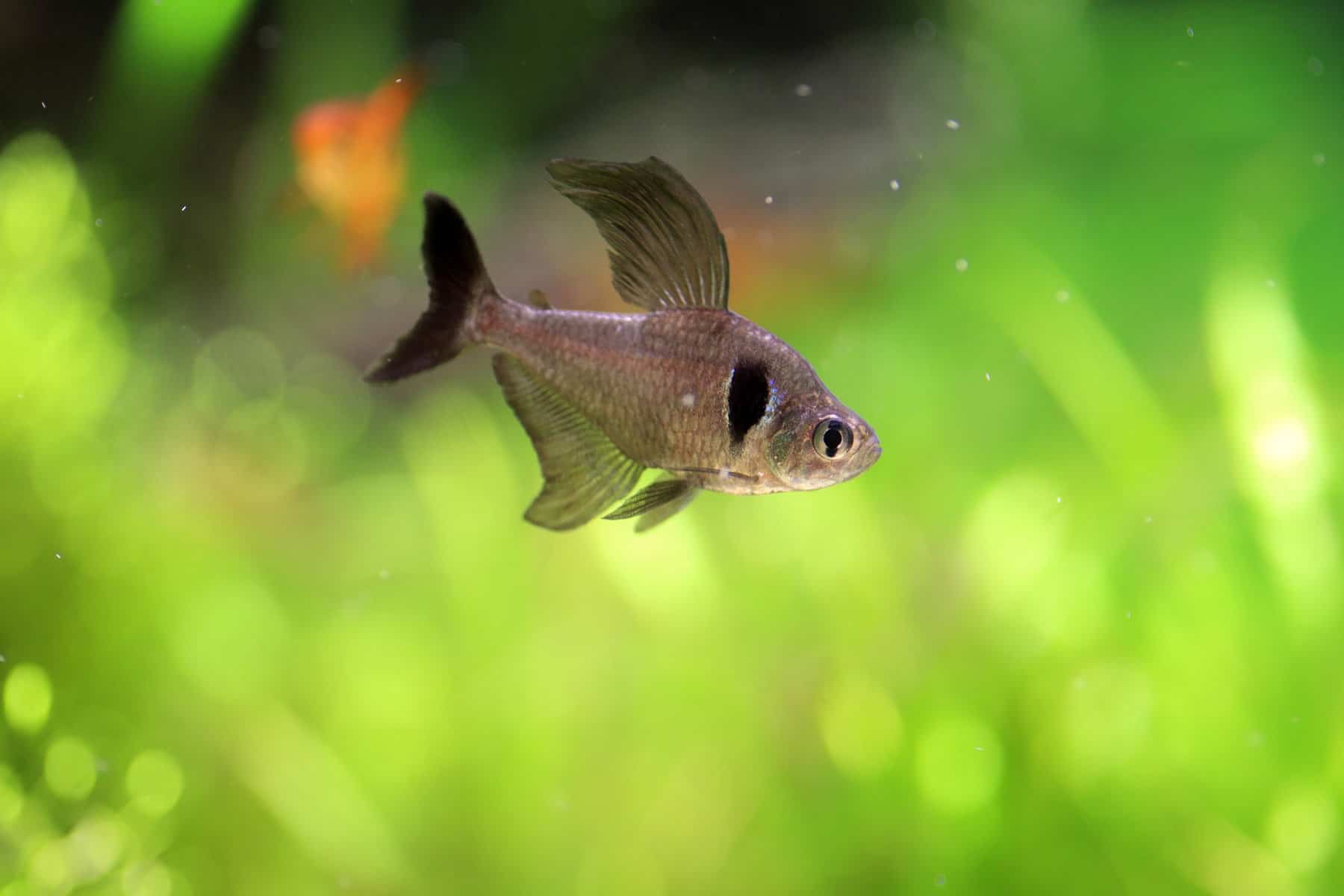
- Scientific name: Megalamphodus megalopterus
- Tank size: 10 gallons (37.9 L)
- Mature size: 1.5 inches (3.8 cm)
The Black Phantom tetra is a very attractive little fish that makes a lively and interesting addition to a tetra tank or community setup.
These South American tetras come from the Guaporé and Upper Paraguay River basins. Black Phantom tetras do best in a heavily planted tank, where they will readily spawn without any special attention or care.
As the male fish mature, their dorsal fin becomes extended and they become darker in color.
Coffee Bean Tetra
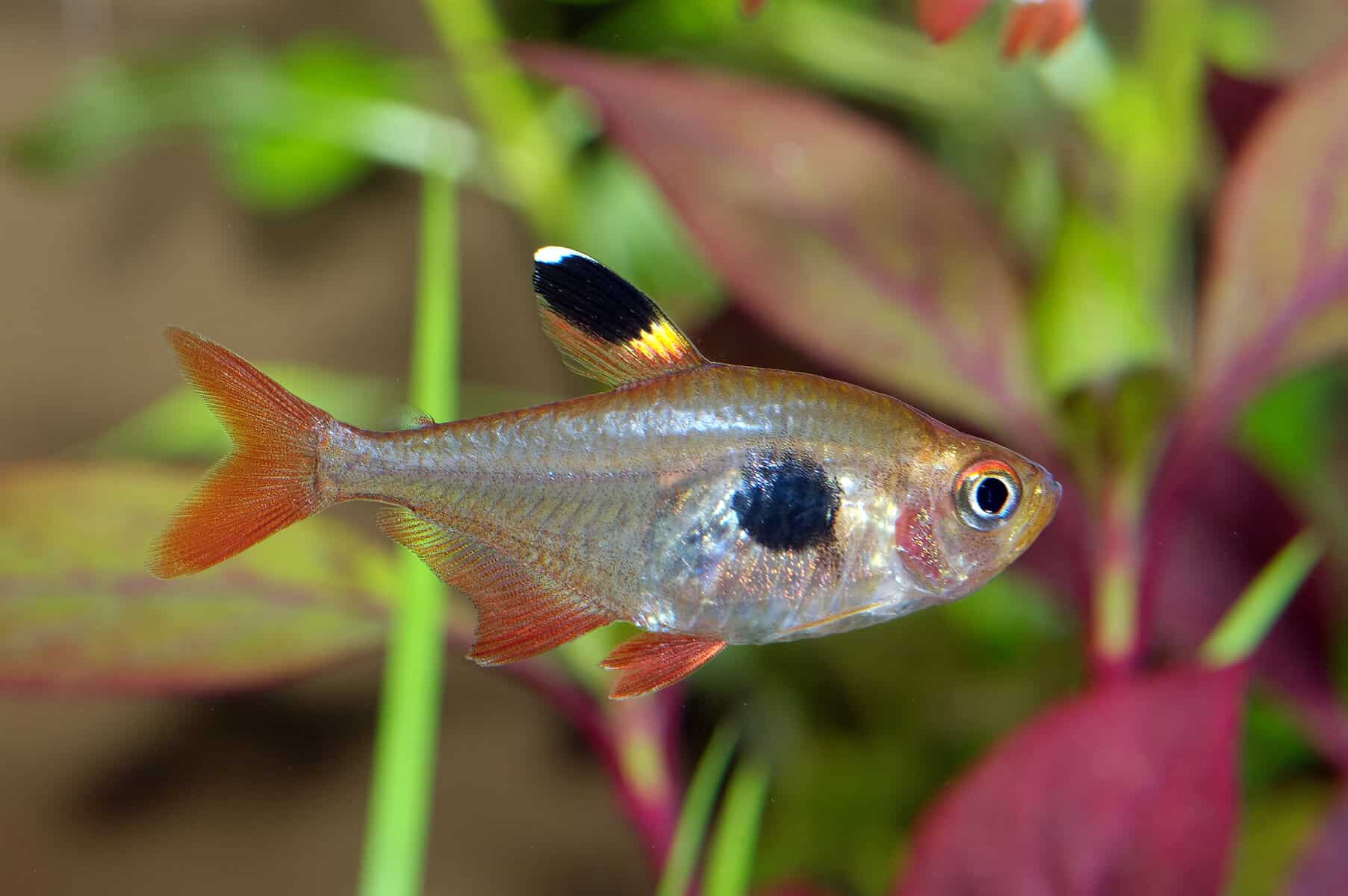
- Scientific name: Hyphessobrycon takasei
- Tank size: 10 gallons (37.9 L)
- Mature size: 1.5 inches (3.8 cm)
The Coffee Bean tetra is a recent arrival on the aquarium hobby scene but has become one of the most sought-after species available.
Coffee Bean tetras originate from the waters of the Oyapock and Araguari River basins in South America. They are named after the oval black marking behind their gills, resembling a coffee bean.
Loreto Tetra
- Scientific name: Hyphessobrycon loretoensis
- Tank size: 10 gallons (37.9 L)
- Mature size: 1 inches (2.5 cm)
The dainty Loreto tetra can make a great alternative to the more commonly seen neon or glowlight tetras (Hemigrammus erythrozonus) and are similar in size.
Loreto tetras come from the Upper Río Amazonas in Peru, preferring a tank with plenty of aquatic plants and acidic water quality.
These are extremely peaceful fish that mix well with pretty much all other species, including bettas.
Tetra Availability
Even though most tetras can be found in abundance at any aquarium store or pet store, it can be difficult to find the more sought-after species.
It can be especially difficult to find species other than Neons and Black Skirts. In addition, it can be very hard to find tetras that are relatively healthy and strong enough to make the transition into your home aquarium.
Sadly, tetras are often seen as disposable fish. Aquarium stores receive them in such large quantities so many are left to die while others get sick and injured. In addition, illness is also very quick to spread through an entire school since there are so many.
For tetras especially, it’s important to go to a reputable seller to give your fish the best chance possible at survival. It is also highly recommended to quarantine the school for at least 3 weeks before introducing them to your main tank.
Tetra Diseases
Tetras are pretty robust, provided that they are kept in their preferred conditions, the tank is well-maintained, and the fish are fed a high-quality diet.
However, all tetra species can be attacked by parasites and succumb to bacterial infections if the fish are weakened by stress or poor water quality.
Conditions to watch out for are ich (white spot disease), fin rot, flukes, and injuries sustained during transportation or as the result of an attack by more aggressive fish.
All these common fish diseases can be treated with disease-specific, over-the-counter products that you’ll find in your local fish or pet store.
Many times, these diseases will go unnoticed. This is because diseases are difficult to see on small fish and because the fish usually ends up in the filter intake before they can be properly diagnosed.
Tetras are notorious for getting caught in filter intakes. Contrary to popular belief, it’s probably not because your filter is too strong.
Instead, it’s likely that the fish was already compromised by an illness. A healthy tetra will be able to swim in a decent current, including that of your filter intake.
If your tetra does get caught in your filter, make sure to check the school for signs of disease over the course of the next few days.
Final Thoughts
Tetras are easy to care for, readily available, and peaceful fish that make excellent additions to any community fish tank.
They are suitable fish for beginner and experienced aquarists, and can quickly add life and excitement to any tank. With over 150 species of tetras to choose from, you’ll never be short of ideas and inspiration for your own aquarium!
If you have any questions about the tetras on this list, other species of tetra, or have kept a tetra-only tank, don’t hesitate to leave a comment below!
[ad_2]
Source link
